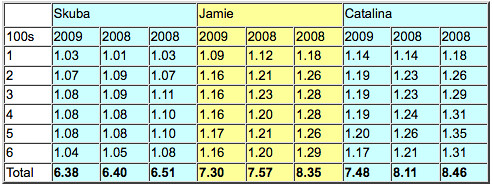Not So Intelligent
By David
I’ve long been a fan of the scholarship of Jonty Skinner. His works on a wide range of swimming subjects have provided insight and wisdom to a generation of coaches. However, his most recent article published in the American Swim Coaches Association Newsletter Volume 2009-01 falls well short of his own high standards.
Before addressing the shortcoming in Jonty Skinner’s work, I find it quite extraordinary that the American Swim Coaches Association continue to publish article after article critical of modern swim suits. There are some things in this sport that are worthy of universal condemnation; for example, smoking bongs, popping steroids, fighting outside bars. Swimsuits are not in that category. There are valid arguments for and against full body suits. An organization that promotes itself as representing all of its members has a duty to address both sides of this sort of debate, not just the views of its executive. In this duty, the American Swim Coaches Association has failed its membership. Their discussion on this subject has been biased, one sided and unenlightened.
But back to Jonty Skinner’s article. Here is a list of what I mean.
“Technological progress – shouldn’t come at the price we appear to have paid.”
And what price is that? Skinner does not tell us. Perhaps he expects us to nod like robots and shrink in fear at the dangers of these body suits. I call it Bush logic. George W. Bush did this all the time: weapons of mass destruction, world terrorism – none of it supported, most of it not even true, just the threat, just the fear. Skinner has learned the Bush logic well.
“These changes have left us all on a slippery slope.”
That sounds bad even if we don’t know what the slippery slope means. And the ultimate Bushism; all this is seriously dangerous when FINA are “not dealing with it very well.” My God we face these dangers and we’re unprotected – call in the Marines; invade Switzerland. Now, I’m no great fan of FINA but the truth is FINA are doing quite a good job of sorting out what swim suits are fair. But that’s not news the conservative wing of swimming want to hear.
And then there is this gem:
“Having said that we’ve just gone through two summers where performances have been radically altered by the suits.”
Again, no evidence is provided to support that outrageous claim. Just because different suits were introduced and swimmers broke records does not prove the suits were the sole cause. And Jonty Skinner should know that. Two events occurring at the same time are not sufficient to establish that one caused the other. What else coincided with swimmers setting these new records? Were swimmers paid more? Did more swimmers have swimming as their sole occupation? Did they have access to better training, nutrition, medical backup and administration support? The answer to all those is yes, yes and yes. Does Jonty Skinner consider any of that? No, it’s just the suits.
But then the ultimate dishonesty – the perfect Bushism:
“Why accept something as genuine when you can tear it down by speculating about the possibility of drugs? You don’t even have to provide evidence; rumors do the job. My own feeling is that it’s not a suggestion I care to make.”
Here, in the middle of an article so full of speculation and rumour, Skinner feels the need to publish a denial just in case anyone picks the deception. In this context “It’s not a suggestion I care to make” is in the same league as, “I don’t want to be rude, but.” Because the sin is denied does not mean it has not occurred. Jonty Skinner may not feel like making a myriad of negative rumours and suggestions. That has not stopped him from doing it.
Although Skinner is South African by birth, he concludes his article with a classic piece of Americana – the French are cheats:
“The suits reduced the function of endurance in the equation. The French sprinters could now finish races with sustained velocity using in some cases inferior techniques.”
So there you have it: the French are unfit and don’t swim as well as Americans. In fact, their fitness and technique are bloody awful. But because of the new suits, those cunning Froggies can now beat us, something they would never be able to do unless they were up to no good. This sort of talk is dishonest and un-American. Clearly the new suits need to be changed if those hideous and inferior French swimmers are using them to unfairly beat clean cut, honest Americans. Jonty Skinner, you should be ashamed.
And in the final paragraph we hear that “the suit is impacting performance on a metabolic and biomechanical level.” Now most readers will know that if your goal is to impress the not-so-bright, use long words. As a final insult to our intelligence Skinner has resorted to that ploy. Certainly metabolic and biomechanical will do. Skinner’s case would have been better served had he spent more time explaining just how the new suits altered a swimmer’s metabolic or biomechanical anything. Certainly that would have been more constructive than depreciating the performance of good French swimmers.




